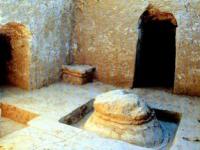You are here
Mele Heyran ancient settl.


Tours to Achal province in Turkemenistan.
"Neither the river, nor bystry time can stop"
Ovidiy.
The ancient settlement Mele Heyran is at east edge of the Serakhs oasis, approximately in 15 km to the East from modern Serakhs and in 300 km to the southeast from Ashgabad in Ahal Region. It themselves the big hill towering almost on 7 meters over the surrounding plain which four small hills from two to three and a half meters high adjoin.
Found excavation on the main hill ruins of the monumental construction serving as the temple of fire. The coins found during excavation are dated late Parthian and sasanids (from Bakhrama of II to Shapour II) the periods that can indicate time of a construction and functioning of the temple is the first centuries of a new era.
All monument is built from square adobe bricks. Walls remained on height to three meters. The temple consisted of several rooms which are directly connected with a cult and probably several more auxiliary. The numerous and well remained details of an interior do Mele Heyran by very important object allowing to reconstruct an ancient cult of the Zoroastrian temple.
These details, it is difficult to present as ancient monuments of this kind are extremely rare and their internal device is almost unknown. That is why, trying to establish purpose of each room Mele Heyran of the temple, researchers are forced to compare it to other sanctuaries despite their significant chronological gap.
The similar temples, next to Serakhs oasis, are found in Akdepe near a strantion Artyk in the Kaakhkins etrap and absolutely nearby, in Dergez that it is located on the Turkmen-Iranian border. On the basis of the detailed analysis of planning structure and other features of the temple in Mele Heyran, professor of the Warsaw university B. Kaim, leaning on researches of a number of the western scientists, defined its main function.
It was the place of storage of "Big", or "Cathedral" fire which in Zoroastrianism was called "Victorious", symbolizing success in continuous fight against the evil. Its name is known: Atash-Bakhram. Such fires to light the burning coal of many sacred fires purified and consecrated during the long rituals.
Opening in Mele Heyram are important for interpretation of the well-known temple of the central part in Ottomans-and Suleyman (Iran) where there was very similar crosswise room with the central dome. Similar design with the square pool filled with ashes were found also during new excavation in Kukh-and Kvadzhe (the Iranian Sistan).
It is possible to consider these three ancient constructions as possible prototypes of the modern Zoroastrian temple, the place of stay of constantly burning victorious fire. In Heyran Mele the lower part of walls with passes and niches, and also a round altar in the center of the hall well remained.
The plaster panels covered with a carved ornament are of great value. It is the first case of detection of an art carving of a sasanids era in Turkmenistan. So fine work of the fine arts confirms deep local traditions of carved scenery in the territory of Khurasan which blossoming is observed in architecture of the XI - XII centuries.
On the ancient settlement Mele Heyran where since 1997 the expedition of Institute of archeology of Warsaw works. In work flow researches of two clay plates covered with a carved ornament from plaster and found at excavation of the Zoroastrian temple of fire on the ancient settlement Mele-Heyran were made.
Despite so respectable age, plates well remained, are decorated with a vegetable ornament with relief images of flowers of a lotus and leaves of a clover. Unique models of the most ancient art are transferred to capital Museum of Fine Arts of Turkmenistan where works on their preservation, restoration of the destroyed details and scientific research of artifacts are now conducted.
Authority:
On materials of information department of the State committee of Turkmenistan on tourism and sport. "Religious and spiritual monuments to Central Asia". Author M. Hashimov. Saga publishing house, 2001.







